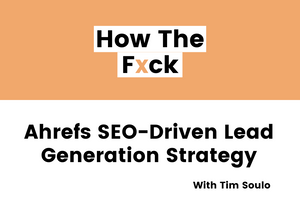Tim Soulo teaches us the Ahrefs lead generation strategy. Copy this for consistent, passive revenue.
Tim Soulo joined Ahrefs with no specific tasks other than to help grow the company, get more customers, get more revenue.
Content turned out to be a great way to build brand awareness, establish thought leadership, and educate more customers.
In this playbook, we detail how Tim and his team use content marketing to drive leads consistently over time with less and less work.
They create content that targets large-volume keywords. That content is very product heavy and aims to add value while displaying the value of the product.
Want to listen to this strategy? Catch the podcast interview here.
SEO Content That Drives Consistent Leads
Playbook
What metric was measured and moved?
Tim grew their blog traffic to 1.5m monthly visitors, but the end goal was always customer acquisition and retention.
Ahrefs has been around for more than 10 years now and JUST THIS YEAR measured blog traffic (because of privacy beliefs for users).
So how did Tim measure the success of each piece of content? Well, growth at all costs is not a priority for Ahrefs, they do things that interest them and are excited about.
They take that approach for content, too. No specific goals i.e., ‘content should drive X leads to be a success’.
Tim’s approach to content is simply to teach people how to use their product. Whenever someone signs up for Ahrefs, if they search in Google or YouTube for ‘how to do X with Ahrefs’ then they should find content that helps them find success and continue using the product.
What’s the strategy?
Content strategy: Create an abundance of educational content about how to use our software and be successful using it. Rank for high-volume searches in Google and position their product as part of the solution to those questions.
Example content: Beginners guide to link building. Note the screenshot of the Ahrefs platform which was used to see how many links a web page has in section two.
Why does this work?
- It makes the product desirable, encouraging sign ups. When you see the product in action, solving the problem you just searched for, you want to buy it.
- Content acts as a segue to your product. Compared to what most people do (write about random fluff topics and hope for brand awareness), this strategy keeps the buyer journey short.
- Low barriers to product use (free trial sign up to get people using the product and seeing value, although now it’s $7 for 7 days of trial).
- Retention: existing customers consume content and learn new ways to use software. Educational content helps people realise the value of the product and stick around to keep using it.
How does Tim design a piece of content to drive leads?
- All content is Ahrefs heavy: “We look at our articles as a custom-made sales page for that problem.”
- When people try to search for something they do, we try to make our content rank there. We see our content as a landing page disguised as a blog post.
How do you make sure your content valuable while being packed full of your own product?
Ahrefs team only writes about topics where:
- They have interesting functionality
- Their product can help you do a strategy even more successfully
Essentially, wherever they are really relevant. This enables them to hijack a topic but still add value.
Google wants to show searchers the most valuable resources that answer their query. As long as people find the content valuable it doesn’t matter if you’re pitching your product there.
Metrics that indicate quality include:
- Time on page
- Dwell time
- Links
How much time is spent on each piece of content?
As much as is needed for it to be good.
How much time is spent promoting content?
Ahrefs promotes content until they’ve exhausted all channels. They then see where the piece of content landed—did it hit number one in search? If not, they look for the flaws in the content and re-write the entire piece. They then promote the article again [this becomes a cycle that continues until the article is ranked number one in Google.]
Methods of promotion:
- Own audience (Twitter, Email, LinkedIn, Facebook Group)
- Advertising (Promote across ad platforms like Twitter, Facebook and Substack)
- Communities (If you are an active member of a community already, not just a spammer)
Limitations of this strategy
Not every product has as much functionality as Ahrefs, so you can’t endlessly talk about it in content writing.
We discussed Basecamp and how they write articles that fit the narrative of their product (improving productivity) but don’t include the product in every piece of content. This way, Basecamp builds an audience and then once in a while introduces their product within an article to engaged readers. Tim suggests starting with your product-related SEO content and expanding when you’ve run out of ideas.
What's your must-follow tip for anyone wanting to copy this strategy?
If you want to drive passive leads consistently for months and months, you need to rank for a popular topic in Google rather than do one off articles.
If you want to increase thought leadership, you need to make your content sharable and viral in nature, not designed for Google search.
Make sure each piece of content is designed with the goal in mind.
Curve ball questions
What's your most controversial marketing opinion?
We don’t use retargeting pixels. We want Ahrefs to be a company that respects people’s privacy, we don’t want to feed our visitor’s information to Google and Facebook.
We also don’t track churn rate or LTV. We have no idea about those kinds of metrics. Still, we’ve been growing successful for 10 years.
You can be successful with a few simple fundamentals and by getting rid of non-essential stuff. Create a product that is extremely useful to people. Forget growth hacks, make your product indispensable.
What myths can we bust about content marketing?
People don’t understand why they’re publishing content.
Your content has cost to create and so it should be valuable enough that you should want to advertise it. —Tim Soulo
Stick ad money behind your content and then your content should be a segue from an ad to your product.
The eyeballs on your content should make people want to buy your product—bringing return on investment. Pitch your company, while answering the question.
How does content marketing contribute to revenue (six ways)
- Direct leads: read the article and sign up.
- Retention: existing customers consume content and learn new ways to use software. Educational content helps people realise the value of the product and stick around to keep using it.
- Account expansions: if someone learns about something that’s not supported on their account they want to upgrade.
- Word of Mouth: Your existing customers will teach their friends only if they themselves fully understand the platform.
- Brand exposure: People prefer things they are familiar with
- Brand affinity/ thought leadership: People want to use the best of the best. If you are positioned as the best, they want to use you.
Tim on Backlink building
How important are backlinks really?
Very because they are like ‘the currency of the web’. They are a very key indicator to Google about what should rank above another article
Backlinks are a great indicator about how successful and competitive your blog post needs to be to rank highly.
How do you design a piece of content to get backlinks?
- Make it something people would want to share with their friends.
- Aim for newsworthiness, shock, educational, entertaining and relevant content
- Create noteworthy content: fancy pictures and visualisations, or statistics. These are things people want to link to. Read Contagious to find out what makes content go viral.


